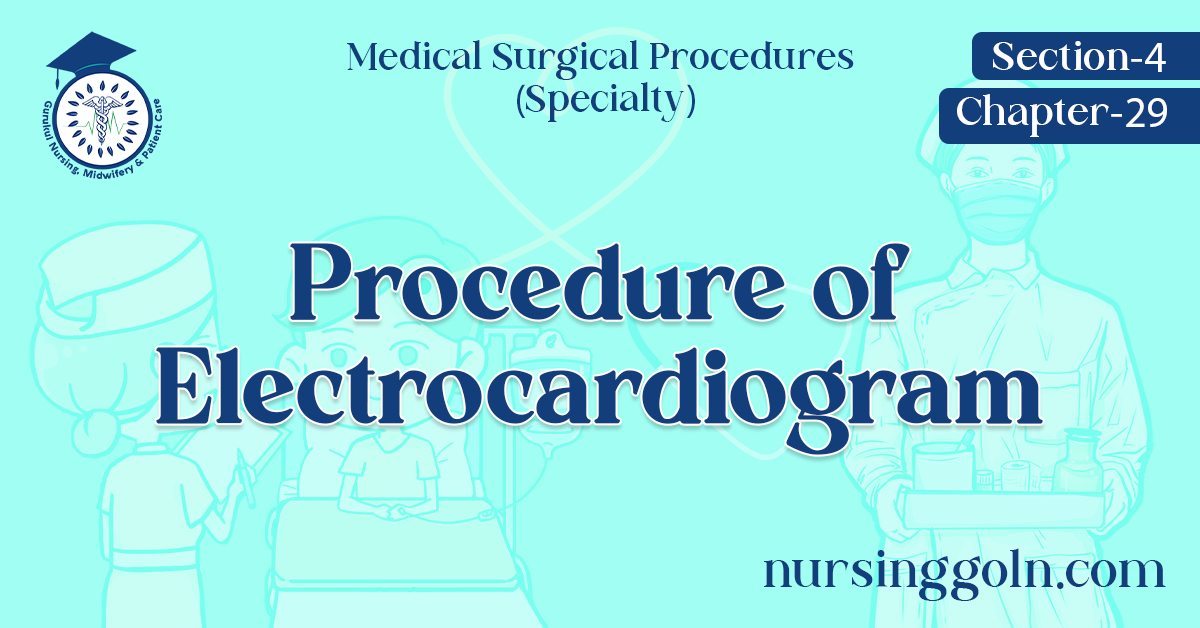Today our topic of discussion is Procedure of Electrocardiogram.
Procedure of Electrocardiogram

Procedure
- Position the patient relaxed and flat Inform the bystanders to keep away, to prevent them touching the patient during procedure
- Enter the identification data of the patient
- Expose the needed area for connecting electrode
- Stay with the patient till it gets over.
After Care
- Clean the patient’s electrode site with gauze or tissue paper
- Ambulate and transfer the patient send the ECG record to doctor for interpretation
- Replace the ECG machine and articles to the proper place
- Record and report in the nurse’s sheet.
Nurses Responsibility
- Nurses working in coronary care unit and intensive care unit should know to operate the ECG machine
- Nurses should able to interpret and identify the dysrhythmia
- Nurses should understand about the dysfunctions and loose connections
- Nurses working in coronary care unit are responsible in ECG interpretation and treating with appropriate life- saving method as per institutional protocol.
Electrocardiogram Consist of Record from 12 Leads
- The three standard bipolar leads (1, 11, 11), three unipolar limb leads (AVR, AVL, AVF) and six unipolar chest leads (VI-V6).
- Lead Placement (Fig. 29.91)
- Lead 1: Right arm to left arm
- Lead II: Right arm to left leg
- Lead III: Left arm to left leg
- AVR: Right arm AVL: Left arm
- AVF: Left foot
- VI: 4th RICS at right sternal border V2: 4th LICS at left sternal border
- V3: Midway between V2 and V4
- V4: 5th LICS at midclavicular line
- V5: 5th LICS at anterior axilliary line
- V6: 5th LICS at midaxillary line.

Indications for 12 Lead ECG
- Dysrhythmia
- Chest pain
- Myocardial infarction
- Heart rate determination
- Hypertrophy or chamber dilatation
- Preoperative assessment
Pericarditis
- Effects of systemic disease on heart
- Effects of electrolyte disturbances.
Cause of Abnormal ECG Pattern
- Skeletal muscle activity or movement of the patient
- Loose electrodes
- Damaged or broken wires
- Improper connections
- Improper placement of electrodes
- Electrical interference.
Preparation of the Patient
- There is no any special preparation for the investigation
- Explain the procedure to the patient and relatives that the seemingly complex apparatus will do no harm but will give information on the action of the heart
- There should not be any ornaments during ECG on the body or the leads should not come in contact with the ornaments
- Apply jelly to the skin where electrode is to be attached to have a good contact between the skin and the electrode
- Give flat and relaxed position to the patient because any movements or muscular twitching recorded by the machine may alter the tracings
- Clean the jelly off the electrode sites before leaving the patient.
- There are specific positions for the placement of the chest leads.
- The improper placement of the chest leads can distort the tracing and alter the diagnosis.

Preprocedural Care
- Check and arrange the ECG machine, cables, and electrodes and needed articles ready in advance
- Explain the procedure clearly to the patient and family
- Check the doctor’s order for the ECG
- Identify the patient name, age, Id No. and diagnosis
- Inform the patient not to move during procedure.
Read more:
